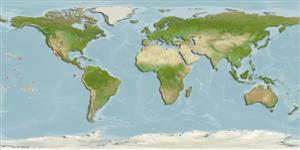Environment: milieu / climate zone / depth range / distribution range
Ecología
marino asociado a arrecife. Tropical; 32°N -
Eastern Pacific: throughout Gulf of California south to Peru. Recorded in the Galapagos Islands during the 1982-83 El Niño (Ref. 9405).
Tamaño / Peso / Age
Maturity: Lm ? range ? - ? cm
Max length : 25.0 cm TL macho / no sexado; (Ref. 9118); common length : 20.0 cm TL macho / no sexado; (Ref. 9118)
Short description
Claves de identificación | Morfología | Morfometría
Body elongate, moderately compressed, and deep, with a strongly arched dorsal profile; snout prominent; mouth small and sub-terminal; lower jaw enclosed by upper; chin with 5 pores but without barbels; edge of preopercle slightly serrate; lower branch of first gill arch with 6 gill rakers; second dorsal fin very long, with 32 to 33 soft rays; body uniformly dark, from purplish bronze to grayish brown; fins dark or blackish (Ref. 55763).
Adults are secretive nocturnal fish that hide under ledges by day and come out only at night to feed on the epifauna of the substrate. The adults sometimes form large inactive aggregations in caves, but little or no feeding occurs. Schools of juveniles appear only in the summer.
Life cycle and mating behavior
Maturities | Reproducción | Spawnings | Egg(s) | Fecundities | Larva
Chao, L.N., 1995. Sciaenidae. Corvinas, barbiches, bombaches, corvinatas, corvinetas, corvinillas, lambes, pescadillas, roncachos, verrugatos. p. 1427-1518. In W. Fischer, F. Krupp, W. Schneider, C. Sommer, K.E. Carpenter and V. Niem (eds.) Guia FAO para identificacion de especies para los fines de la pesca. Pacifico Centro-oriental. 3 volumes. 1813 p. (Ref. 9118)
IUCN Red List Status (Ref. 130435)
Threat to humans
Harmless
Human uses
Pesquerías: escaso valor comercial; Acuario: Acuarios públicos
Herramientas
Special reports
Download XML
Fuentes de Internet
Estimates based on models
Preferred temperature (Ref.
123201): 20.6 - 29.1, mean 25.1 °C (based on 236 cells).
Phylogenetic diversity index (Ref.
82804): PD
50 = 0.5078 [Uniqueness, from 0.5 = low to 2.0 = high].
Bayesian length-weight: a=0.00851 (0.00413 - 0.01752), b=3.08 (2.91 - 3.25), in cm total length, based on LWR estimates for this (Sub)family-body shape (Ref.
93245).
Nivel trófico (Ref.
69278): 3.5 ±0.37 se; based on food items.
Resiliencia (Ref.
120179): Alto, población duplicada en un tiempo mínimo inferior a 15 meses (Preliminary K or Fecundity.).
Fishing Vulnerability (Ref.
59153): Low vulnerability (15 of 100).
Nutrients (Ref.
124155): Calcium = 70.8 [36.4, 114.2] mg/100g; Iron = 0.672 [0.340, 1.125] mg/100g; Protein = 19.5 [18.2, 20.9] %; Omega3 = 0.154 [0.084, 0.231] g/100g; Selenium = 35.3 [21.3, 64.1] μg/100g; VitaminA = 81.1 [27.7, 265.5] μg/100g; Zinc = 1.3 [0.9, 1.8] mg/100g (wet weight);
